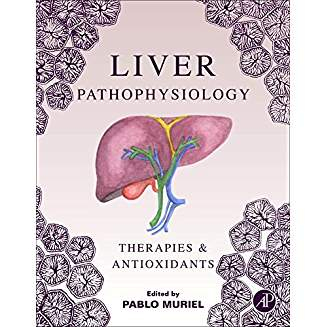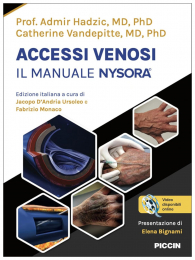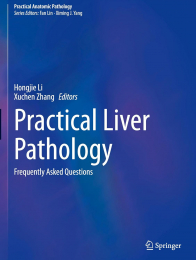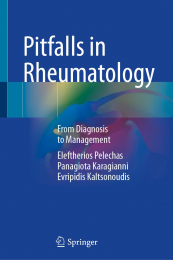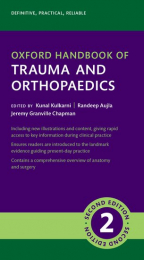Non ci sono recensioni
DA SCONTARE
Features:
- Presents the most recent advances in hepatology, with a special focus on the role of oxidative stress in liver injury.
- Provides in vivo and in vitro models to study human liver pathology.
- Explains the beneficial effects of antioxidants on liver diseases.
- Contains the most recent and modern treatments of hepatic pathologies, including, but not limited to, stem cells repopulation, gene therapy and liver transplantation.
Section I. Introduction
Chapter 1. The Liver: General Aspects and Epidemiology
- Abbreviated History of Hepatology
- Liver Anatomy and Physiology
- Liver Cells
- Liver Zonation Allows Functional Plasticity
- Global Liver Epidemiology
Chapter 2. Structure and Ultrastructure of the Normal and Diseased Liver
- Introduction
- Normal Liver Cell Types
- Pathology of the Diseased Liver
- Concluding Remarks
Section II. Liver Pathophysiology
Chapter 3. Hepatic Apoptosis and Necrosis: Mechanisms and Clinical Relevance
- Introduction of Hepatic Injury
- Apoptosis and Necrosis
- Mechanism of Liver Injury and Disease Relevance
- Therapeutic Strategies for Liver Injury
- Summary
Chapter 4. Autoimmune Hepatitis
- Selection and Presentation of Indigenous Foreign Antigens
- Breaking Immune Tolerance of Self-Antigens
- Neoantigens and Epitope Spread
- Implicated Self-Antigens
- Cell Mediators of Liver Injury
- Molecular Mechanisms of Immune-Mediated Liver Injury
- Overview
Chapter 5. Pathogenesis of Idiosyncratic Drug Induced Liver Injury
- Epidemiology of Idiosyncratic Drug Induced Liver Injury
- Factors Contributing to the Development of Idiosyncratic Drug Induced Liver Injury
- Individual Host Factors
- Expression and Polymorphisms of Hepatocyte Transporters
- Adaptive Immune System
- Genetic Variations and Polymorphisms in Human Leukocyte Antigen
- Defective Adaptation
- Conclusion
Chapter 6. Acetaminophen
- Introduction
- Acetaminophen Metabolism
- Mitochondrial Protein Adducts and Acetaminophen Hepatotoxicity
- Mitochondrial Oxidative and Nitrosative Stress
- Amplification of Mitochondrial Oxidative Stress: Role of c-Jun N-Terminal Kinase
- Mitochondrial Permeability Transition and DNA Damage
- Mode of Hepatocyte Cell Death After Acetaminophen Toxicity
- Sterile Inflammation and Acetaminophen Hepatotoxicity
- Clinical Biomarkers in Acetaminophen Hepatotoxicity
Chapter 7. Liver Regeneration
- Introduction
- Normal Turnover (Homeostasis) of the Liver
- Liver Regeneration After Partial Hepatectomy
- Molecular Mechanisms of Liver Regeneration After Partial Hepatectomy
- Liver Regeneration After Different Models of Hepatic Injury
- Nomenclature and Niche of Hepatic Progenitor Cells
- Hepatic Progenitor Cells Activation in Human Liver Diseases
- Oval Cells/Hepatic Progenitor Cells Contribution to Liver Regeneration
- Signaling Pathways Regulating Hepatic Progenitor Cells Activation and Differentiation
- TWEAK/Fn14 Signaling
- Fibroblast Growth Factor 7
- Stromal-Cell-Derived Factor 1
- Hedgehog Signaling
- Wnt and Notch Signaling
- Contribution of Bone Marrow Cells to Liver Regeneration
Chapter 8. Nitric Oxide in Liver Ischemia-Reperfusion Injury
- Introduction
- Mechanisms of Liver Ischemia-Reperfusion Injury
- Mechanisms of Nitric Oxide on Liver Ischemia-Reperfusion Injury
- Potential Therapeutic Effect of Nitric Oxide on Liver Ischemia-Reperfusion Injury
- Summary
Chapter 9. The Immune System and Viral Hepatitis
- Introduction
- Immune Response and Viral Hepatitis
- Immune Response to Hepatitis A Virus and Hepatitis E Virus
- Immune Response to Hepatitis C Virus and Hepatitis B Virus
- Lipid Metabolism and Hepatitis C Virus: Immune Control
- Heme Metabolism and Immune Modulation During Viral Hepatitis
- Final Remarks
Chapter 10. The Pathophysiology of Alcoholic Liver Disease
- Highlights
- Introduction
- Steatosis
- Oxidative Stress
- Inflammasomes
- Macrophages
- Neutrophilic Infiltration of the Liver
- Role of Complement in Alcoholic Hepatitis Pathogenesis
- Role of Hypoxia
- The Effect of Nutrition on Alcoholic Liver Disease
- Epigenetic Changes in Gene Expression in Alcoholic Liver Disease
- Histone Acetylation and Methylation in Experimental Alcoholic Liver Disease
- Microarray Analysis
- Lipopolysaccharides and Toll-Like Receptor 4 and the Blood Alcohol Cycle
- Balloon Cell Change and Mallory-Denk Body Formation
- Cell Cycle Arrest in Alcoholic Hepatitis
- Liver Fibrosis in Alcoholic Liver Disease
Chapter 11. Cytokines in Steatohepatitis
- Introduction
- Tumor Necrosis Factor
- Interleukins
- Interferons
- Conclusive Remarks
Chapter 12. Redox Signaling in NASH
- Introduction
- Characteristics of the Pathogenesis of Nonalcoholic Fatty Liver Disease
- Conclusion
Chapter 13. Amebic Liver Abscess
- Introduction
- Prevalence of Amebic Liver Abscess
- Clinical Manifestations
- Pathology
- Experimental Hepatic Amebiasis
- Humoral Response
- Cellular Response
- Diagnosis
- Chemotherapy
- Surgical Treatment
- Vaccination
Chapter 14. Role of Cytokines and Reactive Oxygen Species in the Amebic Liver Abscess Produced by Entamoeba histolytica
- Introduction
- Animal Models of Amebiasis
- Role of Cytokines in the Amebic Liver Abscess
- Reactive Oxygen Species in the Pathogenesis of the Amebic Liver Abscess
- Conclusions
Chapter 15. Epigenetics in Liver Disease: Involvement of Oxidative Stress
- Introduction
- Oxidative Stress, Alcohol, and Epigenetics
- Nonalcoholic Fatty Liver Disease
- Conclusions
Chapter 16. Role of Oxidative and Nitrosative Stress in Hepatic Fibrosis
- Introduction
- Oxidative Stress: Concept and Formation
- Oxidative Stress and Redox Signaling in Liver Fibrosis
- Nitrosative Stress in Liver Fibrosis
- Conclusions
Chapter 17. Oxidative and Nitrosative Stress in Chronic Cholestasis
- Introduction
- Liver Injury
- Oxidative Stress
- Nitrosative Stress
- Oxidative and Nitrosative Stress: An Interplay?
- Mitochondrial Oxidative Changes
- Conclusions
Chapter 18. Cholestasis, Contraceptives, and Free Radicals
- Cholestasis
- Liver Effects of Contraceptives: Cholestasis and Oxidative Stress
- Other Hepatic Effects by Contraceptives
- Conclusions
Chapter 19. Is Human Cirrhosis a Reversible Disease?
- Introduction
- Chronic Liver Disease
- Fibrosis and Cirrhosis
- Fibrosis and Cirrhosis Regression
- Cirrhotic Hepatitis B
- Cirrhotic Hepatitis C
- Alcohol Cirrhosis
- Reversibility of Fibrosis and Cirrhosis
- Alcohol Cirrhosis
- Nonalcoholic Liver Disease and Fibrosis
- Autoimmune Cirrhosis
- Antifibrotic Therapy
Chapter 20. Obesity and Hepatocellular Carcinoma
- Introduction
- Obesity and Hepatocellular Carcinoma Incidence
- Nonalcoholic Fatty Liver Disease and Hepatocellular Carcinoma Incidence
- Hepatocellular Carcinoma in Noncirrhotic Liver With Nonalcoholic Fatty Liver Disease
- Molecular Mechanisms of Hepatocarcinogenesis in Obesity-Related Hepatocellular Carcinoma
- Adiponectin and Leptin
- Endoplasmic Reticulum Stress
- Oxidative Stress
- Genetic Factor (Patatin-Like Phospholipase Domain-Containing 3)
- Epigenetic Changes (HDAC8, MicroRNAs)
- Peroxisome Proliferator-Activated Receptor Alpha
- Farnesoid X receptor
- Phosphatase and Tensin Homolog and P-Akt/Mammalian Target of Rapamycin Complex Pathway
- Tumor Necrosis Factor Alpha and Interleukin-6
- Insulin-Like Growth Factors
- C-Jun Amino Acid-Terminal Kinases
- Gut Microbiome
- Toll-Like Receptor 4
- Obesity-Related Hepatocellular Carcinoma Prevention and Therapy
- Exercise
- Statins
- Metformin
- Probiotics
- Summary
- Disclosure Statement
Chapter 21. Oxidative Stress as a Mechanism for Hepatocellular Carcinoma
- Hepatocellular Carcinoma and Oxidative Stress
Chapter 22. Nuclear Factor-Kappa B Actions During the Development of Hepatocellular Carcinoma
- Introduction
- Nuclear Factor-Kappa B Activation and Function
- Nuclear Factor-Kappa B Activation and Liver Carcinogenesis
- Nuclear Factor-Kappa B Activation During Hepatocarcinogenesis in Animal Models
- Conclusion
Chapter 23. The Role of Senescence in Hepatic Diseases
- Introduction
- Pathways of Senescence
- Oxidative Stress and Liver Cell Senescence
- Hepatic Diseases and Senescence
- Conclusion
Chapter 24. Exercise, Liver Steatosis, and Free Radicals
- The Role of Oxidative Stress in Nonalcoholic Fatty Liver Disease
- Hepatic Redox Modulation Induced by Acute and Chronic Exercise
- Exercise Mitigates Nonalcoholic Fatty Liver Disease-Induced Liver Oxidative Stress
- Conclusions
Chapter 25. The Metabolic Syndrome, Oxidative Stress, and the Liver
- Introduction
- Definition of Metabolic Syndrome
- Epidemiology of Metabolic Syndrome and Nonalcoholic Fatty Liver Disease
- Oxidative Stress
- The Metabolic Syndrome and Oxidative Stress
- Nonalcoholic Fatty Liver Disease, Insulin Resistance, and Oxidative Stress
- Conclusions
Chapter 26. Liver Diseases in the Elderly
- Changes Found in the Aged Liver
- Liver Diseases in the Elderly
- Summary
Chapter 27. Cytokines in Hepatic Injury
- Macrophage Heterogeneity, Cytokines, and Liver Injury
- Cytokines and Basic Liver Pathophysiology
- Cytokines in Various Hepatic Injuries
- Conclusions
Chapter 28. Nrf2: A Key Regulator of Redox Signaling in Liver Diseases
- Introduction
- General Principles of Nrf2 Signaling
- Role of Nrf2 in Liver Diseases
- Conclusion
Chapter 29. Redox Regulation by HGF/c-Met in Liver Disease
- Introduction
- Hepatocyte Growth Factor/c-Met Redox Regulation and Liver Diseases
- Conclusion
Section III. Liver Metabolism
Chapter 30. Hepatic Metabolism in Liver Health and Disease
- Introduction
- Hepatic Carbohydrates Metabolism
- Hepatic Lipid Metabolism
- Hepatic Protein Metabolism
- Hepatic Drug Metabolism
Chapter 31. Cytochrome P450 and Oxidative Stress in the Liver
- Introduction
- Microsomal Mixed Function Oxidase and Cytochrome P450 Metabolism
- Mixed Function Oxidase Activity
- CYP2E1-Reactive Oxygen Species and Ethanol-Induced Liver Injury
- Conclusions and Perspectives
Chapter 32. Drug Hepatic Clearance in Spinal Cord Injury
- Background: Clinical and Experimental Observations on Pharmacokinetic Alterations Due to Spinal Cord Injury
- Effects of Experimental Spinal Cord Injury on Phenacetin and Naproxen Clearance in Rats
- What Do We Know About Spinal Cord Injury-Induced Changes in Liver Function and Drug Disposition
Section IV. Cirrhosis and Its Complications
Chapter 33. Complications of Cirrhosis: Introduction
- Introduction
- Complications of Cirrhosis
- Concluding Remarks
Chapter 34. Portal Hypertension-Molecular Mechanisms
- Introduction
- Physiology of Portal Pressure
- Pathophysiology of Portal Hypertension
- Molecular Mechanisms of Portal Hypertension
- Summary
Chapter 35. Gastroesophageal Varices
- Definition and Clinical Significance
- Pathophysiology of Portosystemic Collateral Circulation
- Development of Portosystemic Collaterals: Preexistent and De Novo
- Assessment of Varices
- Rationale for the Management of Varices
- Clinical Scenarios for the Treatment of Portal Hypertension
Chapter 36. Ascites
- Pathogenesis
- Pathophysiological Bases for the Treatment of Ascites
- Management of Cirrhotic Ascites
- Conclusions
Chapter 37. Reactive Nitrogen and Oxygen Species in Hepatic Encephalopathy
- Introduction
- Hepatic Encephalopathy
- Manganese
- Ammonia
- Other Pathogenic Mechanisms Generating Reactive Nitrogen and Oxygen Species in the Brain
- Conclusions
Chapter 38. Hepatorenal Syndrome
- Introduction
- Pathophisiology of HRS
- Diagnosis
- Differential Diagnosis
- Precipitating Factors
- Treatment of HRS
Chapter 39. Hepatopulmonary Syndrome and Portopulmonary Hypertension
- Hepatopulmonary Syndrome
- Portopulmonary Hypertension
- Summary
Section V. Methods in Liver Disease
Chapter 40. Experimental Models of Liver Damage Mediated by Oxidative Stress
- Introduction
- Carbon Tetrachloride Is a Useful Model to Induce Acute and Chronic Liver Damage
- Acetaminophen Intoxication as Model of Acute Liver Injury
- Models of Cholestasis
- Ischemia/Reperfusion Liver Injury Models Serve to Improve Liver Transplantation Surgery
- Concanavalin A Is a Good Model That Mimics Autoimmune Hepatitis
- Liver Damage Induced by Alcohol in Rats
- d-Galactosamine and Lipopolysaccharides Induce Liver Damage Through Activating the Immune System
- Thioacetamide Produces Chronic Liver Injury Through Free Radical Attack to Macromolecules
- Dimethyl or Diethyl Nitrosamine Produces Necrosis, Fibrosis, and Cancer
- Dietary Models Used to Acquire a Nonalcoholic Fatty Liver Disease/Nonalcoholic Steatohepatitis Phenotype
- Gold Thioglucose+High-Fat Diet
- Concluding Remarks
Chapter 41. Monitoring of Liver Fibrogenesis and Biochemical Diagnosis of Fibrosis
- Introduction
- Current Biomarkers of Hepatic Fibrogenesis
- Class I Fibrosis Biomarkers
- Class II Fibrosis Biomarkers
- Development of Innovative Biomarkers
- NX-Des-y-carboxyprothrombin
- Conclusion
Chapter 42. In Vitro Models of HCC
- Introduction
- General Overview and Traits of a Multistage Malignant Process
- Cell Models for the Study of Hepatocellular Carcinoma Initiation Stage
- Cell Models for the Study of Hepatocellular Carcinoma Promotion Stage
- Cell Models for the Study of Hepatocellular Carcinoma Progression Stage
- Comparative Analysis of Hepatocellular Carcinoma Cell Lines
- Frequency of Use for Research Purposes
- Pharmacological Studies in Hepatocellular Carcinoma Cell Lines
- Studies With Antioxidants
- Combination of Antioxidants With Different Drugs in Hepatocellular Carcinoma Cell Lines
- Conclusions
Section VI. Therapies in Liver Disease
Chapter 43. The Liver, Oxidative Stress, and Antioxidants
- Introduction
- Oxidative Stress
- The Overproduction of Free Radicals in Biological Systems
- Antioxidants
- Nuclear Erythroid 2-Related Factor 2/Antioxidant Response Element Pathway in Liver Diseases
- Antioxidants From Natural Sources and Some of Its Hepatoprotective Effects
- Conclusion
Chapter 44. Herbal Drugs on the Liver
- Introduction
- Plants as Hepatoprotective Agents
- Polyherbal (Multiingredient) Formulations as Hepatoprotective Agents
- Problems With Polyherbal Formulations
- Chemistry of Hepatoprotective Herbal Drugs
- The Mechanism(s) of Action
- Active Phytochemicals as Hepatoprotective Agents
- Development of Hepatoprotective Herbal Drugs
Chapter 45. Silymarin for Liver Disease
- The History of Milk Thistle
- Biochemistry
- Pharmacokinetics
- Pharmacological Studies
- Alcohol-Induced Liver Disease
- Nonalcoholic Fatty Liver Disease
- Viral Hepatitis
- Toxic and Iatrogenic Liver Disease
- Mushroom Poisoning
- Hepatocellular Carcinoma
- Conclusion
Chapter 46. Naringenin and the Liver
- Introduction
- Knowing Naringenin
- Pharmacokinetics of Naringenin
- The Naringenin in Fibrogenic Signaling Pathways
- Beneficial Effects of Naringenin in Liver Diseases
- Pharmaceutical Technology of Naringenin
- Safety and Toxicity of Naringenin
- Conclusions and Perspectives
Chapter 47. Antioxidant, Antiinflammatory, and Antifibrotic Properties of Quercetin in the Liver
- Introduction
- Structure-Activity Relationship of Quercetin
- Metal-Chelating Activity of Quercetin
- Pharmacokinetics of Quercetin
- Hepatoprotective Effects of Quercetin
- Quercetin and Inflammation
- Quercetin in the Treatment of Hepatocellular Carcinoma
- Pharmaceutical Technology of Quercetin
- Toxicological Effects
- Conclusions and Perspectives
Chapter 48. Coffee and the Liver
- Introduction
- Chemical Composition of Coffee
- Beneficial Effects of Coffee on Liver Disease
Chapter 49. Hepatoprotective Properties of Curcumin
- Introduction
- Antiinflammatory Properties of Curcumin in the Liver
- Antifibrotic Properties of Curcumin in the Liver
- Anticancer Properties of Curcumin in the Liver
- Antiviral Properties of Curcumin in the Liver
- Antiheavy Metal Properties of Curcumin in the Liver
- Antisteatosis Properties of Curcumin in the Liver
- Conclusions and Perspectives
Chapter 50. Retinoids in Liver Function
- What Is a Retinoid?
- Dietary Intake and Intestinal Absorption of Retinoids
- Cellular Formation of Retinal and Retinoic Acid
- Hepatic Retinoids and Liver Diseases
- Effect of Retinoids on Iron Metabolism
- Effect of Retinoids on Insulin Resistance in Liver
- Activation of AMPK by Retinoids
- Identification of the Responsive Genes of All-trans Retinoic Acid
- Retinoid Metabolism in Nonalcoholic Fatty Liver Disease
Chapter 51. Stevia as a Putative Hepatoprotector
- Introduction
- Conclusions and Perspectives
Chapter 52. Are N-Acetylcysteine and Resveratrol Effective Treatments for Liver Disease?
- Introduction
- Overview of NAC and Resveratrol: Chemical Properties and Pharmacokinetic Aspects
- Pharmacodynamic Properties and Clinical Applications
- Effects of NAC and Resveratrol in Liver Diseases
- Side-Effects and Toxicology of NAC and Resveratrol
- NAC and Resveratrol Formulations
- Conclusions and Perspectives
Chapter 53. Does Nutrition Matter in Liver Disease?
- Introduction
- Malnutrition as a Consequence of Liver Disease
- Evaluation of Nutrition Status in Liver Disease
- Nutritional Treatment of Liver Disorders
- Conclusion and Perspectives
Chapter 54. One-Carbon Metabolism in Liver Health and Disease
- Introduction
- Hepatic One-Carbon Metabolism
- S-Adenosylmethionine Treatment in Liver Disease
Chapter 55. Ursodeoxycholic Acid for the Treatment of Liver Diseases
- History of Ursodeoxycholic Acid
- Physicochemical Properties and Pharmacokinetics of UDCA
- Pharmacological Activities of UDCA
- Mechanisms of UDCA Action
- Clinical Use and Efficacy of UDCA
Chapter 56. Current Treatment of Chronic Hepatitis C
- Interferon-Free Treatment Regimens
- Unresolved Issues
- Conclusions
Chapter 57. An Adenosine Derivative Compound as a Hepatoprotective Agent
- Introduction
- Concluding Remarks and Perspectives
Chapter 58. Nitric Oxide and the Liver
- Introduction
- Sources and Regulation of NO in the Liver
- NO Signaling in Liver
- Pathophysiology
- Conclusion: NO and the Liver
Chapter 59. Repopulation of Cirrhotic Liver by Hepatic Stem/Progenitor Cells: A Promising Strategy Alternative to Liver Transplantation
- Introduction
- Emergence of Cell Therapy for Liver Diseases
- Hepatocytes Transplantation
- Stem Cell-Based Therapy for Liver Cirrhosis
- Stem Cells Repopulation in Cirrhotic Liver Through Different Routes/Sites
- Immunobiology of hHSPCs Transplantation
- Alternative Strategies for the Development of Bioartificial Liver Using hHSPCs Repopulation
- Stem Cells Imaging and Tracking: From Bench to Bedside
- Concluding Remarks
Chapter 60. Gene Therapy for Liver Disease
- Introduction
- Mechanisms of Liver-Directed Gene Therapy
- Delivery Systems for Gene Therapy
- Viral Vectors
- Nonviral Vectors
- Conclusions
Chapter 61. Role of Oxidative Stress in Liver Transplantation
- Introduction
- Role of Oxidative Stress in Ischemia-Reperfusion Associated With Liver Transplantation
- Strategies to Decrease Oxidative Stress in I/R Associated With Liver Transplantation
- Future Directions in Researching on Oxidative Stress in Ischemia-Reperfusion Injury Associated With Liver Transplantation

